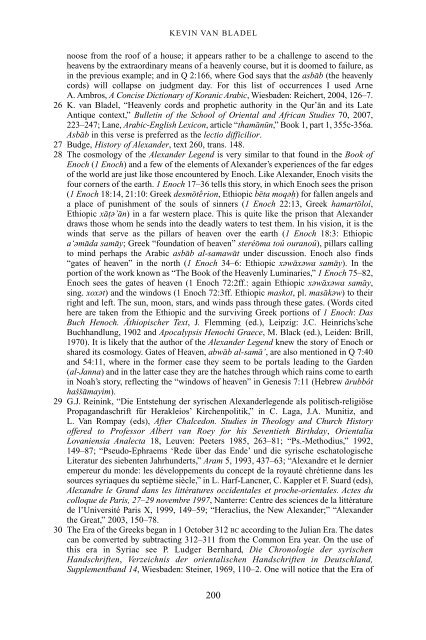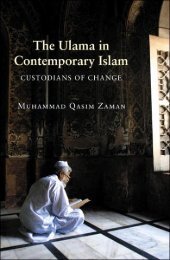The Qur'an in its historical context (pdf - Islam and Christian-Muslim ...
The Qur'an in its historical context (pdf - Islam and Christian-Muslim ...
The Qur'an in its historical context (pdf - Islam and Christian-Muslim ...
Create successful ePaper yourself
Turn your PDF publications into a flip-book with our unique Google optimized e-Paper software.
KEVIN VAN BLADEL<br />
noose from the roof of a house; it appears rather to be a challenge to ascend to the<br />
heavens by the extraord<strong>in</strong>ary means of a heavenly course, but it is doomed to failure, as<br />
<strong>in</strong> the previous example; <strong>and</strong> <strong>in</strong> Q 2:166, where God says that the asbab (the heavenly<br />
cords) will collapse on judgment day. For this list of occurrences I used Arne<br />
A. Ambros, A Concise Dictionary of Koranic Arabic, Wiesbaden: Reichert, 2004, 126–7.<br />
26 K. van Bladel, “Heavenly cords <strong>and</strong> prophetic authority <strong>in</strong> the Qur’an <strong>and</strong> <strong>its</strong> Late<br />
Antique <strong>context</strong>,” Bullet<strong>in</strong> of the School of Oriental <strong>and</strong> African Studies 70, 2007,<br />
223–247; Lane, Arabic-English Lexicon, article “thamanun,” Book 1, part 1, 355c-356a.<br />
Asbab <strong>in</strong> this verse is preferred as the lectio difficilior.<br />
27 Budge, History of Alex<strong>and</strong>er, text 260, trans. 148.<br />
28 <strong>The</strong> cosmology of the Alex<strong>and</strong>er Legend is very similar to that found <strong>in</strong> the Book of<br />
Enoch (1 Enoch) <strong>and</strong> a few of the elements of Alex<strong>and</strong>er’s experiences of the far edges<br />
of the world are just like those encountered by Enoch. Like Alex<strong>and</strong>er, Enoch vis<strong>its</strong> the<br />
four corners of the earth. 1 Enoch 17–36 tells this story, <strong>in</strong> which Enoch sees the prison<br />
(1 Enoch 18:14, 21:10: Greek desmotérion, Ethiopic beta moq7h) for fallen angels <strong>and</strong><br />
a place of punishment of the souls of s<strong>in</strong>ners (1 Enoch 22:13, Greek hamartoloí,<br />
Ethiopic xat7’an) <strong>in</strong> a far western place. This is quite like the prison that Alex<strong>and</strong>er<br />
draws those whom he sends <strong>in</strong>to the deadly waters to test them. In his vision, it is the<br />
w<strong>in</strong>ds that serve as the pillars of heaven over the earth (1 Enoch 18:3: Ethiopic<br />
a‘7mada samay; Greek “foundation of heaven” steréoma toû ouranoû), pillars call<strong>in</strong>g<br />
to m<strong>in</strong>d perhaps the Arabic asbab al-samawat under discussion. Enoch also f<strong>in</strong>ds<br />
“gates of heaven” <strong>in</strong> the north (1 Enoch 34–6: Ethiopic x7wax7wa samay). In the<br />
portion of the work known as “<strong>The</strong> Book of the Heavenly Lum<strong>in</strong>aries,” 1 Enoch 75–82,<br />
Enoch sees the gates of heaven (1 Enoch 72:2ff.: aga<strong>in</strong> Ethiopic x7wax7wa samay,<br />
s<strong>in</strong>g. xox7t) <strong>and</strong> the w<strong>in</strong>dows (1 Enoch 72:3ff. Ethiopic maskot, pl. masak7w) to their<br />
right <strong>and</strong> left. <strong>The</strong> sun, moon, stars, <strong>and</strong> w<strong>in</strong>ds pass through these gates. (Words cited<br />
here are taken from the Ethiopic <strong>and</strong> the surviv<strong>in</strong>g Greek portions of 1 Enoch: Das<br />
Buch Henoch. Äthiopischer Text, J. Flemm<strong>in</strong>g (ed.), Leipzig: J.C. He<strong>in</strong>richs’sche<br />
Buchh<strong>and</strong>lung, 1902 <strong>and</strong> Apocalypsis Henochi Graece, M. Black (ed.), Leiden: Brill,<br />
1970). It is likely that the author of the Alex<strong>and</strong>er Legend knew the story of Enoch or<br />
shared <strong>its</strong> cosmology. Gates of Heaven, abwab al-sama’, are also mentioned <strong>in</strong> Q 7:40<br />
<strong>and</strong> 54:11, where <strong>in</strong> the former case they seem to be portals lead<strong>in</strong>g to the Garden<br />
(al-Janna) <strong>and</strong> <strong>in</strong> the latter case they are the hatches through which ra<strong>in</strong>s come to earth<br />
<strong>in</strong> Noah’s story, reflect<strong>in</strong>g the “w<strong>in</strong>dows of heaven” <strong>in</strong> Genesis 7:11 (Hebrew ÷rubbôt<br />
hammamayim).<br />
29 G.J. Re<strong>in</strong><strong>in</strong>k, “Die Entstehung der syrischen Alex<strong>and</strong>erlegende als politisch-religiöse<br />
Propag<strong>and</strong>aschrift für Herakleios’ Kirchenpolitik,” <strong>in</strong> C. Laga, J.A. Munitiz, <strong>and</strong><br />
L. Van Rompay (eds), After Chalcedon. Studies <strong>in</strong> <strong>The</strong>ology <strong>and</strong> Church History<br />
offered to Professor Albert van Roey for his Seventieth Birthday, Orientalia<br />
Lovaniensia Analecta 18, Leuven: Peeters 1985, 263–81; “Ps.-Methodius,” 1992,<br />
149–87; “Pseudo-Ephraems ‘Rede über das Ende’ und die syrische eschatologische<br />
Literatur des siebenten Jahrhunderts,” Aram 5, 1993, 437–63; “Alex<strong>and</strong>re et le dernier<br />
empereur du monde: les développements du concept de la royauté chrétienne dans les<br />
sources syriaques du septième siècle,” <strong>in</strong> L. Harf-Lancner, C. Kappler et F. Suard (eds),<br />
Alex<strong>and</strong>re le Gr<strong>and</strong> dans les littératures occidentales et proche-orientales. Actes du<br />
colloque de Paris, 27–29 novembre 1997, Nanterre: Centre des sciences de la littérature<br />
de l’Université Paris X, 1999, 149–59; “Heraclius, the New Alex<strong>and</strong>er;” “Alex<strong>and</strong>er<br />
the Great,” 2003, 150–78.<br />
30 <strong>The</strong> Era of the Greeks began <strong>in</strong> 1 October 312 BC accord<strong>in</strong>g to the Julian Era. <strong>The</strong> dates<br />
can be converted by subtract<strong>in</strong>g 312–311 from the Common Era year. On the use of<br />
this era <strong>in</strong> Syriac see P. Ludger Bernhard, Die Chronologie der syrischen<br />
H<strong>and</strong>schriften, Verzeichnis der orientalischen H<strong>and</strong>schriften <strong>in</strong> Deutschl<strong>and</strong>,<br />
Supplementb<strong>and</strong> 14, Wiesbaden: Ste<strong>in</strong>er, 1969, 110–2. One will notice that the Era of<br />
200



